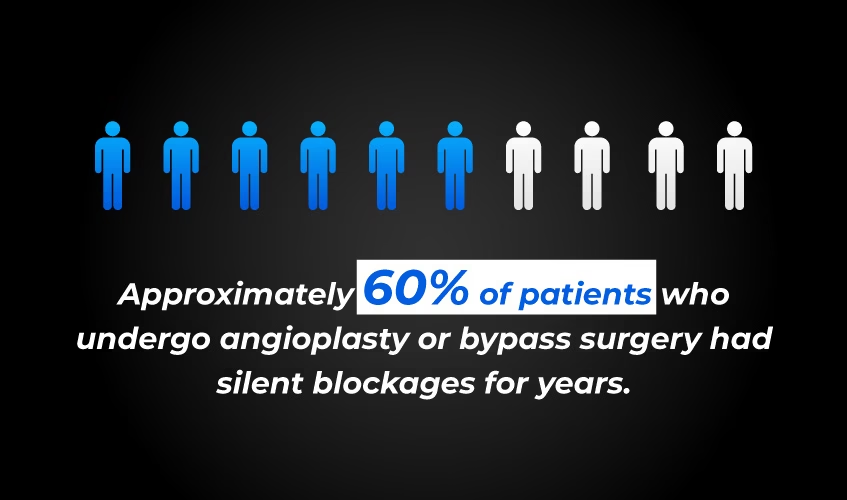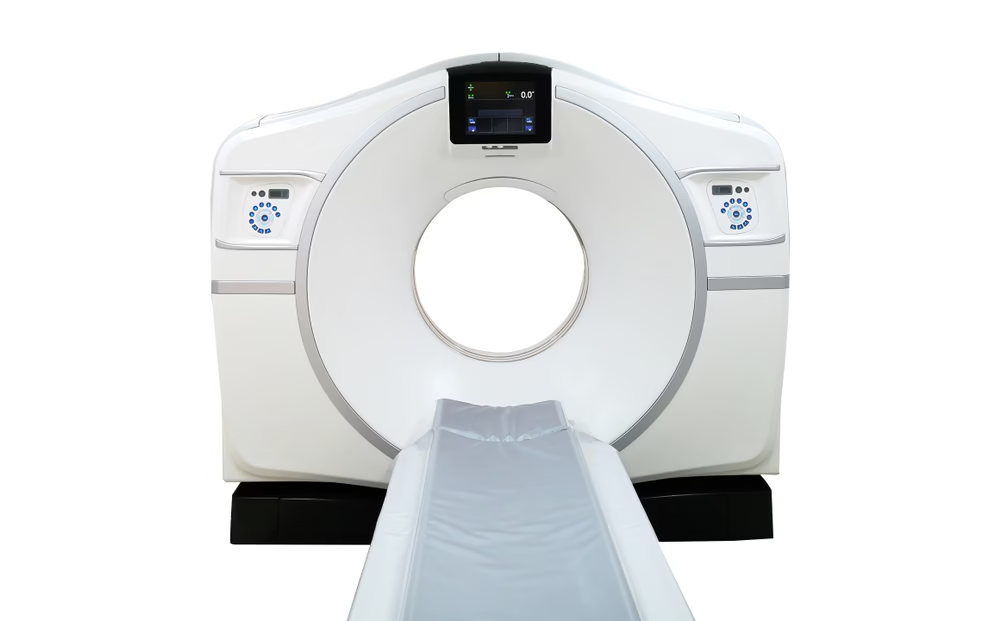If you are reading this, you have probably already been told about heart blockages, bypass surgery, or the fear of having another angioplasty of some kind. And at that scary moment, you might have wondered: Is there a safer way to truly know what’s going on in my heart without the risk of an open-heart operation? And yes, there is!
At SAAOL Heartcare Delhi, under the guidance of Dr. Bimal Chhajer, we believe that non-invasive heart treatments like EECP Treatment in Delhi/NCR and advanced diagnostics are the future of heart care. For many patients, this means a non-surgical solution is in sight, like a path that offers an alternative to bypass surgery, which helps you to avoid bypass surgery and reverse heart disease that too without surgery.
Yet, very few people even know CT Angiography. Let’s break it down simply.
Table of Contents
ToggleWhat is CT Angiography?
CT Angiography (CTA) is a modern imaging examination. It combines a CT scan with a contrast dye injected into your blood. This results in a three-dimensional picture of your heart’s arteries.
It’s like Google Maps, but for the blood vessels in your heart. It shows every road, every blockade, every shortcut, and that without having to thread catheters into your body.
Traditional angiography = invasive.
CT angiography = non-invasive.
Why This CT Angiography Matters in India
India is facing a never-before-seen heart disease crisis. The average Indian develops heart disease 10 years earlier than Western counterparts. By the age of 40, nearly 1 in 4 Indians already has hidden blockages that may not yet cause symptoms.
But the alarming part is:

Approximately 60% of patients who undergo angioplasty or bypass surgery had silent blockages for years. When chest pain occurs, the disease has advanced. CT angiography is changing this. It enables physicians to observe blockages early, without surgery, without pain, without hospitalization.
CT Angiography vs Conventional Angiography: Cost in India and Best Uses
| Feature | CT Angiography | Conventional Angiography |
| Invasive or Non-invasive | Non-invasive (no tubes) | Invasive (catheter in artery) |
| Hospital Stay | Same-day, walk out | Often requires admission |
| Risks | Minimal (low radiation) | Higher (bleeding, infection, artery damage) |
| Pain | Painless | Discomfort, insertion pain |
| Cost | ₹20,000 (varies by city) Discounted price from SAAOL Heartcare | 25,000 – ₹40,000+ |
| Best Use | Early detection, follow-up, and low-risk patients | Emergency blockages, stenting planning |
What are the Benefits of CT Angiography?
- CTA has 95% sensitivity in detecting heart blockages.
- For blockages greater than 70%, its accuracy reaches 98%.
- It can also identify soft plaques (the dangerous kind that can suddenly rupture), which conventional angiography often misses.
- It is non-invasive, cost-effective, quick, and totally painless.
- It guides treatment decisions – Helps doctors decide if you really need surgery or if a non-surgical approach like EECP at SAAOL Heartcare Delhi can work.
Who Should Consider CT Angiography?
It’s particularly helpful if you have:
- Family history of heart disease
- An episode of chest pain or breathlessness that cannot be explained
- Have risk factors such as diabetes, smoking, high BP, and high cholesterol
- Already had a bypass surgery or angioplasty, and wants to take a look at your arteries without undergoing another invasive test
- Need a less shaky second opinion before a rush to surgery
Who Is Not Suitable for CT Angiography?
While CT angiography is safe for most people, there are a few situations where it may not be the best choice:
- Severe kidney problems – Because the test uses a contrast dye, people with poor kidney function may be at risk of kidney damage.
- Allergy to contrast dye – Patients who have had serious allergic reactions to iodine-based contrast should avoid CTA.
- Pregnant women – Radiation, even though low, is generally avoided during pregnancy.
- Uncontrolled irregular heart rhythms – Conditions like atrial fibrillation can blur images and reduce test accuracy.
- Very high heart rate – If the heart is beating too fast and cannot be slowed with medication, clear imaging may not be possible.
- Very obese patients – In some cases, body size may limit the accuracy of imaging, though newer machines have improved this limitation.
- Patients unable to hold breath – The test requires holding your breath for a few seconds; those unable to do so may not get clear images.
Can CT Angiography Help Avoid Bypass Surgery?
It’s at this point that patients raise the most crucial question: “If I do CT angiography, can I avoid surgery?”
Yes, CTA can help many patients avoid bypass surgery if the test is performed early because it often reveals that the blockages are not as severe as they were assumed.
Many people have heart blockage that could be treated without surgery, including through lifestyle modifications, dietary changes, EECP treatment, and medications. SAAOL Heartcare Delhi takes the CTA as the major diagnostic parameter when it comes to accurately measuring the heart blockages. With our reversal programs, we are thus in a position to offer an option to reverse heart disease without surgery in Delhi/NCR.
Latest Generation of CT Angiography Machines

The latest generation of CTA machines is transforming heart care. Unlike older scanners, these machines now use multi-slice detectors (320-slice, 640-slice), Dual Source CT (DSCT), and emerging photon-counting detectors. These technologies mean:
- Sharper images of even tiny coronary blockages.
- Faster scans (within a heartbeat).
- Lower radiation exposure makes it safer for patients.
- More accuracy in people with irregular heartbeats, obesity, or high calcium scores, where traditional scans often failed.
At SAAOL Heartcare Delhi, Dr. Bimal Chhajer and his team prefer these advanced scanners because they help patients avoid unnecessary invasive angiography and instead explore safer, non-surgical heart disease treatments.
Comparison: Old vs. New CT Angiography
| Feature | Older CT Angiography | Latest-Gen CT Angiography (320/640-slice, DSCT, Photon-Counting) |
| Image Quality | Limited, sometimes blurred | Ultra-sharp, 3D high-resolution |
| Scan Speed | Slower, multiple heartbeats | Single heartbeat (fractions of seconds) |
| Radiation Dose | Higher exposure | Up to 70% lower radiation |
| Heart Rhythm Handling | Poor in irregular heartbeat | Reliable even in arrhythmias |
| Calcium Interference | Often inaccurate | Advanced software reduces calcium artifacts |
| Patient Comfort | Longer breath-holds | Short breath-hold, quick procedure |
| Diagnostic Accuracy | Moderate | Near 95–99% sensitivity & specificity |
This is why SAAOL Heartcare Delhi chooses the latest CTA technology; it’s faster, safer, clearer, and more reliable for guiding patients toward treatments that can reverse heart disease without surgery.
SAAOL Heartcare: The Future of Heart Care in India
We’re moving into a prevention age now with CT Angiography, not a reactionary one. Imagine a world where:
- You don’t sit around waiting to get chest pain to know you have heart disease.
- You receive a clear map of your arteries in your 30s or early 40s.
- You heal the disease with diet, EECP, and lifestyle before you ever consider surgery.
This is the vision of heart specialists such as Dr. Bimal Chhajer and the team at SAAOL Heartcare Delhi – a method in which non-surgical treatment of heart disease is not merely a substitute for invasive therapy but rather the preferred choice.
Conclusion
CT Angiography is not a test like any other. It is a revolution in the way India can address its heart disease crisis. For patients terrified about going for the surgery, it provides access to finding out how their heart is doing, that are not only safer, but quicker as well.
In trained hands and when combined with strategies such as EECP treatment in Delhi/NCR, it provides the patient with the ability to avoid bypass surgery and even to reverse heart disease without surgery!
Heart disease doesn’t wait. Neither should you. If you’re at risk, the question is: Do you prefer to wait for the problem, or to see it early and reverse it?
If you need help with non-surgical heart treatment and want to choose the most cost-effective option, then contact SAAOL Heartcare today!
Common FAQs
Q: Is CT Angiography painful?
No. It’s like a CT scan. No tubes, no stitches, no cutting.
Q: How long does a CT angiography take?
15–20 minutes. You get to walk home the same day.
Q: Is CT angiography safe for the kidneys?
The dye can stress the kidneys. Patients with renal disease require pre-screening, and SAAOL doesn’t suggest CTA with regular dye for them. There is a kidney-friendly dye for kidney patients at an extra cost.
Q: Can CT Angiography replace angioplasty?
No. It’s a diagnostic tool. It shows the problem. Treatment depends on results.
Q: Does CT angiography detect heart disease early enough?
Yes. Unlike conventional angiography, it can also show the build-up of plaque before blockages large enough to cause major symptoms develop.


